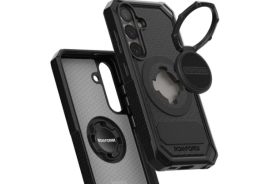The Samsung Galaxy Note 3 is undoubtedly one of the most popular devices currently on the market, but the newly-unveiled Xperia Z1S might give it a run for its money.
Sony has launched its high-end Xperia Z1 a while ago, but up until now U.S. customers were left out of the loop. The company has now announced its new Xperia Z1S, which is the U.S. version of its popular Xperia Z1 flagship. The Samsung Galaxy Note 3, meanwhile, has stirred lots of waves and enjoys great popularity worldwide.
Both the Sony Xperia Z1S and the Samsung Galaxy Note 3 are powerful devices with top-notch specs and features, but how do they fare against each other? Let's take a look at the specs and compare the two.
Processor
The Samsung Galaxy Note 3 comes in two versions: one is powered by a quad-core Qualcomm Snapdragon 800 processor clocked at 2.3GHz, and the other packs an Octa-core Exynos 5 processor clocked at 1.9GHz. In terms of graphics, the Note 3 features either an Adreno 330 GPU or Mali T-628 MP6 graphics. Both CPU and GPU vary depending on region. The Sony Xperia Z1S, meanwhile, packs a Qualcomm Snapdragon 800 quad-core CPU and an Adreno 330 GPU.
Display
Samsung bumped up the screen size with its latest Galaxy Note phablet, which boasts a massive 5.7-inch display with a full HD resolution of 1920 x 1080 pixels and a pixel density of 386 pixels per inch (ppi). The Sony Xperia Z1S comes with a 5-inch Triluminos display with a full HD resolution and a pixel density of 441 pixels per inch (ppi).
RAM and Storage Capacity
The Samsung Galaxy Note 3 comes with a hefty 3GB of RAM and is available in three configurations with 16, 32, or 64GB of internal storage, along with a microSD card slot that allows for up to 64GB of additional memory. The Sony Xperia Z1S features 2GB of RAM and a single storage configuration of 32GB, also expandable up to 64GB via microSD.
Camera
The Samsung Galaxy Note 3 has a 13-megapixel rear shooter with autofocus, LED flash, optical image stabilization (OIS), and HDR, as well as a 2-megapixel front-facing camera. The Sony Xperia Z1S boasts a 20.7-megapixel rear camera with autofocus, LED flash, optical image stabilization (OIS), HDR, and a 2-megapixel front shooter.
Operating System (OS)
On the software side, the two devices balance the scales. Both the Galaxy Note 3 and the Xperia Z1S run Android 4.3 Jelly Bean, with a future update to Android 4.4 KitKat in the cards. The winner in this category will be whomever gets the upgrade first.
Battery Performance
The Samsung Galaxy Note 3 comes with a large 3,200 mAh battery, while the Sony Xperia Z1S features a 3,000 mAh battery. It's worth noting here, however, that although the Note 3 packs a larger battery, it also has a considerably larger display to juice up.
Other Features
The Samsung Galaxy Note 3, as expected, comes with the popular S Pen stylus and enhanced functionality. The Sony Xperia Z1 S, on the other hand, is more rugged and durable, as it is dust- and waterproof with IP58 rating.
Conclusion
While this brief comparison doesn't mention the slew of exciting features available with each of the two, it does give a good look at the core specifications. If you prefer a powerful smartphone that doesn't have a huge display, but boasts a high-end camera and is waterproof and dust-resistant, the Sony Xperia Z1S may be the one for you. On the other hand, if you prefer a larger device with a hefty amount of RAM, a good camera, stylus functionality and the popular Samsung-exclusive array of apps, the Samsung Galaxy Note 3 may be a better fit.
Both of these devices are real powerhouses and rock top-of-the-line specifications, so ultimately the choice comes down to personal taste and needs. It's also worth noting, however, that the Sony Xperia Z1S will launch on Jan. 22 as a T-Mobile exclusive in the U.S., which limits your options to a single carrier.
© Copyright 2026 Mobile & Apps, All rights reserved. Do not reproduce without permission.













